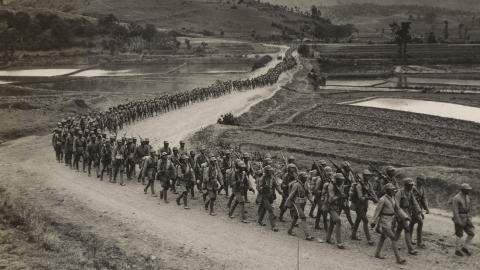The Battle of Stalingrad
War: World War II.
Dates: 23rd August 1942 – 2nd February 1943.
Place: Stalingrad, Soviet Union.
Belligerents: Nazi Germany and The Axis vs The Soviet Union.
Just under a thousand kilometres south of Moscow and sitting on the strategically-vital River Volga connecting the Caucasus and the Caspian Sea to the country’s eastern regions, Stalingrad (known as Volgograd since 1961) was, during World War II, one of the Soviet Union’s most important industrial centres and communication hubs.
Having rebuffed an attack on the western part of the country in the winter of 1941-42 – one with the ultimate goal of taking Moscow – Stalin and the upper echelons of the Red Army that included future leader Nikita Khrushchev were waiting for the Nazis to have another go at the capital.
But Hitler had ideas on Stalingrad. Notwithstanding the strategic importance of the city, it was one that bore the name of his nemesis and there was no better propaganda to take home. He decreed that upon taking the city, every male occupant would be killed and the women and children deported. For similar reasons, Stalin felt a special need to defend his city at all costs.
What ensued was the largest and bloodiest battle in the history of warfare. Around two million soldiers died as well as 400,000 civilians and it signalled the start of the march towards a decisive Allied victory in World War II.
The mother of all battles
On August 23rd 1942, the 6th Army of the Wehrmacht under General Friedrich von Paulus alongside the 4th Panzer Army began their offensive on Stalingrad.
Oddly, Stalin decided against evacuating the city’s 400,000 residents in the belief that their presence would inspire his troops to fight harder. As the battle raged, the Luftwaffe dropped 1,000 tons of bombs on the city, effectively reducing it to rubble. However, this was a catastrophic misjudgement that potentially cost Germany the entire war.
For soldiers used to exceptionally-well choreographed mobile warfare, hand-to-hand street fighting in the Stalingrad suburbs, in and out of houses and down alleyways and narrow streets was a chastening experience for the Germans.
It’s said that the average life expectancy for Soviet troops on the ground when fighting was at its zenith was less than 24 hours.
By mid-September, the Luftwaffe controlled the skies and the Soviets were getting desperate. They had already suffered huge losses and civilians not already involved in armament production were asked to chip in. Men were ordered to fight, often without weapons, and women were enlisted to dig trenches at the front.
So determined was Stalin not to lose his city he issued the now famous Order No. 227: ‘Not a step back!’ Civilians who surrendered or retreated would suffer trial by military tribunal and if found guilty, execution.
As the harsh Soviet winter drew in, both sides faced serious problems, mainly with their ability to get supplies to the troops on the ground. Soviet supplies had to come across the Volga under heavy shelling and many of the units were decimated before they’d even had a chance to fight. They were so desperate for numbers they used political prisoners held in penal units for suicidal charges. It’s said that the average life expectancy for Soviet troops on the ground when fighting was at its zenith was less than 24 hours.
The Germans were also in trouble. They were quickly running out of food, medical supplies and ammunition and it was virtually impossible to airdrop what they needed to sustain any meaningful offensive.
On 19th November, the German death knell rang out. The Soviets, led by generals Georgy Zhukov and Aleksandr Vasilevsky, launched a brilliantly-conceived counterattack known as Operation Uranus from the mountainous regions to the north and west of Stalingrad, circling the city with a million men and trapping the 6th Army within its ring of steel.
There was nowhere to go. They were tired, freezing and hungry. In December, General Erich von Manstein hastily-arranged a relief operation to try and get vital supplies to the German and Axis soldiers who were by now fenced in. It failed. Their last hope for a most unlikely victory was gone. The 6th Army was doomed.
The brutality of the Soviet winter didn’t stop the Germans from having one last crack at a fight although in reality, their chances of a win had all but gone. Fighting in conditions to which they were neither accustomed to nor indeed dressed or nourished for was a waste of time. Soviet forces consolidated their positions around the city and tightened the circle, cutting off any last chances to get supplies through.
Yet still, as a matter of almost psychotic pride and principle, Hitler refused to surrender despite his generals on the ground abandoning hope weeks previously and an offer, known as ‘terms of capitulation’, made to Paulus from the Red Army High Command. It offered surrender in return for the guaranteed safety of all PoWs, food, medical supplies and repatriation to the country of their choosing after the war had finished.
In the last week of January 1942, the Russians moved in for the kill and took their city back.
The Führer insisted that the army stand fast ‘to the last soldier and the last bullet’ and on the 30th January, the 10th anniversary of Hitler’s ascension to power he promoted Paulus to the rank of Generalfeldmarschall. Not, one would think, out of respect for the man who, in hindsight, fought an unwinnable battle, but because no German field marshal had ever surrendered and he would be the highest-ranking German soldier to be caught. It was suicide or fight to the last while tens of thousands of German and Axis troops either starved or froze to death.
It was the latter, sort of. On the 2nd February, General Karl Strecker was told that one of his men had met with the Red Army to negotiate the terms of surrender. With that, he radioed back to Wehrmacht HQ telling them that they had in fact fought to the last man and his command had done its duty. He then promptly surrendered. Paulus, by the way, claimed no knowledge of the surrender…
Hitler was apoplectic with rage. He said of Paulus that he ‘could have freed himself from all sorrow and ascended into eternity and national immortality, but he prefers to go to Moscow.’
Something like 91,000 men were taken prisoner including 22 generals. Virtually all of them perished in Soviet prison camps, some were held back in the city to help with the rebuild, a handful of senior-ranked officers were taken to Moscow and paraded around as propaganda puppets. Only around 5,000 made it home, some not until the mid-1950s.
As for Friedrich von Paulus, he stayed in the Soviet Union until 1952 when he moved to the East German city of Dresden and spent the rest of his days defending his actions in Stalingrad. He died there in February 1957.
The defeat at Stalingrad was the first time the Nazi war machine publicly acknowledged failure and it smashed its own reputation for absolute invincibility. But they didn’t just suffer embarrassment. In order to replenish troops on the Eastern Front, they had to pull vast numbers from the Western Front and with that, the tide turned in favour of the Allies.
As late as November 1944, Hitler blamed Stalingrad for the Nazi’s impending defeat. And it came, in the shape of a crushing Allied victory just a few short months later.
















